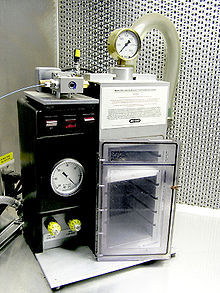 The gene gun or the Biolistic Particle Delivery System, originally designed for plant transformation, is a device for injecting cells with genetic information. The payload is an elemental particle of a heavy metal coated with plasmid DNA. This technique is often simply referred to as biolistic.
The gene gun or the Biolistic Particle Delivery System, originally designed for plant transformation, is a device for injecting cells with genetic information. The payload is an elemental particle of a heavy metal coated with plasmid DNA. This technique is often simply referred to as biolistic.
Design of gene gun
The gene gun was originally a Crosman air pistol modified to fire dense tungsten particles. The design was first used on onions to deliver particles coated with a phosphorescent marker gene. Genetic transformation can then be proven when the onion tissue expresses the gene.
How the Gene Gun Works
The gene gun is part of a method called the biolistic (also known as bioballistic) method, and under certain conditions, DNA (or RNA) become “sticky,” adhering to biologically inert particles such as metal atoms (usually tungsten or gold). By accelerating this DNA-particle complex in a partial vacuum and placing the target tissue within the acceleration path, DNA is effectively introduced (Gan, 1989). Uncoated metal particles could also be shot through a solution containing DNA surrounding the cell thus picking up the genetic material and proceeding into the living cell. A perforated plate stops the shell cartridge but allows the slivers of metal to pass through and into the living cells on the other side. The cells that take up the desired DNA, identified through the use of a marker gene (in plants the use of GUS is most common), are then cultured to replicate the gene and possibly cloned. The biolistic method is most useful for inserting genes into plant cells such as pesticide or herbicide resistance. Different methods have been used to accelerate the particles: these include pneumatic devices; instruments utilizing a mechanical impulse or macro projectile; centripetal, magnetic or electrostatic forces; spray or vaccination guns; and apparatus based on acceleration by shock wave, such as electric discharge
APPLICATION OF GENE GUN
PLANTS: The target of a gene gun is often a callus of undifferentiated plant cells growing on gel medium in a petri dish. After the gold particles have impacted the dish, the gel and callus are largely disrupted. However, some cells were not obliterated in the impact, and have successfully enveloped a DNA coated gold particle, who’s DNA eventually migrates to and integrates into a plant chromosome. The device uses a bullet to propel genes (DNA) into the cell structure, though the bullet is simply the power behind the process. Cells from the entire petri dish can be re-collected and selected for successful integration and expression of new DNA using modern biochemical techniques, such as a using a tandem selectable gene and northern blots. Introduction of foreign DNA into subcellular compartments using the gene gun precludes any escape of introduced foreign genes through pollen grains.
Higher discharge pressures allow for the delivery of DNA to deeper tissues. Using the new gene gun to deliver a luciferase expression plasmid resulted in higher levels of gene expression in the skin than observed with conventional guns, as well as in subdermal tissues, including subcutaneous tumors. Selected single cells from the callus can be treated with a series of plant hormones, such as auxins and gibberellins, and each may divide and differentiate into the organized, specialized, tissue cells of an entire plant. This capability of total re-generation is called totipotency. The new plant that originated from a successfully shot cell may have new genetic (heritable) traits. The use of the gene gun may be contrasted with the use of Agrobacterium tumefaciens and its Ti plasmid to insert genetic information into plant cells
Humans and animals
Bio-Rads Helios gene gun system delivers DNA to the epidermis using helium-driven bombardment of DNA-coated gold micro-particles. The nature of immune responses generated following vaccination with DNA depends on a number of key factors, such as the route, method, and vaccination schedule employed. We have therefore performed a series of pilot experiments with a DNA plasmid that encodes the hepatitis B surface antigen (HBsAg) to investigate the use of the Helios gene gun system in a Balb/c mouse model. A comparison has been made between delivery of this plasmid by gene gun and by intramuscular injection. Gene guns have also been used to deliver DNA vaccines to experimental animals. Theoretically, it may be used in humans as well. The delivery of plasmids into rat neurons through the use of a gene gun, specifically DRG neurons, is also used as a pharmacological precursor in studying the effects of neurodegenerative diseases such as Alzheimer’s disease.
The gene gun technique is also popularly used in an edible vaccine production technique, where the nano-gold particles coated with plant genetic material under the high vacuum pressurized chamber are transformed into suitable plant tissues. The gene gun has become a common tool for labeling subsets of cells in cultured tissue. In addition to being able to transfect cells with DNA plasmids coding for fluorescent proteins, the gene gun can be adapted to deliver a wide variety of vital dyes to cells. Gene gun bombardment has also been used to transform C. elegans, as an alternative to microinjection.







